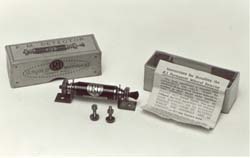1 - THE PRE-HISTORY OF ELETRONICS
For historic allocation purposes the
electronic age started in 1837 with the invention of the telegraphy
by Samuel
In the same time the French researcher E. Branley invented a device known as coherer, made of a small glass tube filled with loose iron filings. In this device, when the electromagnetic waves or signals struck the metallic part they cohered - thus its name - and so occuring the detection. Guglielmo Marconi, an Italian scientist, in 1896 transmitted electromagnetic waves at a distance of 3600 meters by using a spark transmitter similar the one used by Hertz, but now provided with an aerial. In the receiver he used a coherer as a wave detector. In 1906, H.A. Dundwoody and G.W. Pickard working simultaneously to get a more reliable electromagnetic wave detector discovered the property that same crystals like the galena and the quartz; they could detect Hertezian waves and thus developing the famous crystal radio receiver. |
